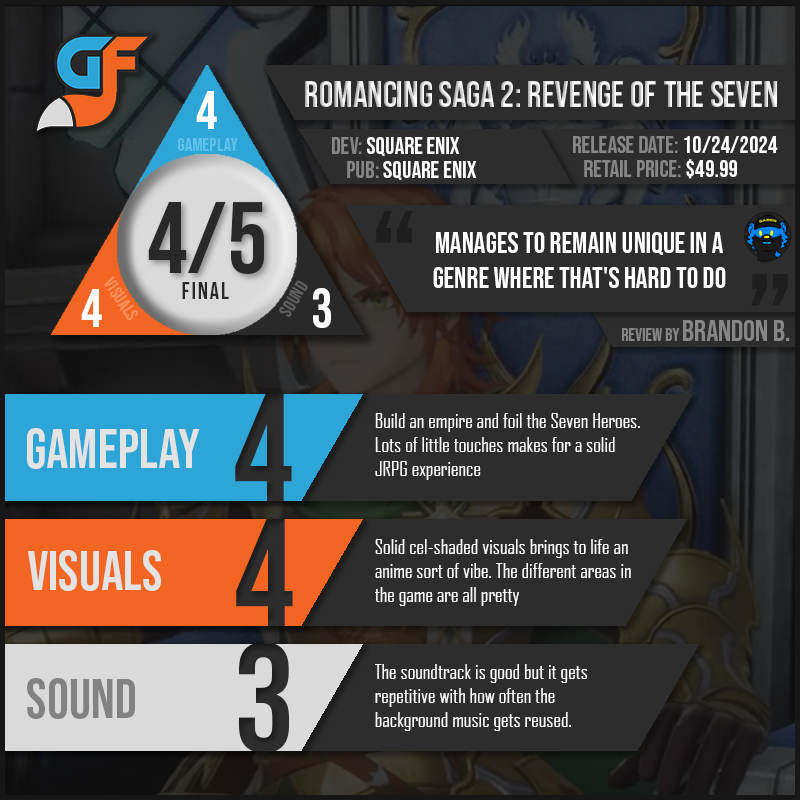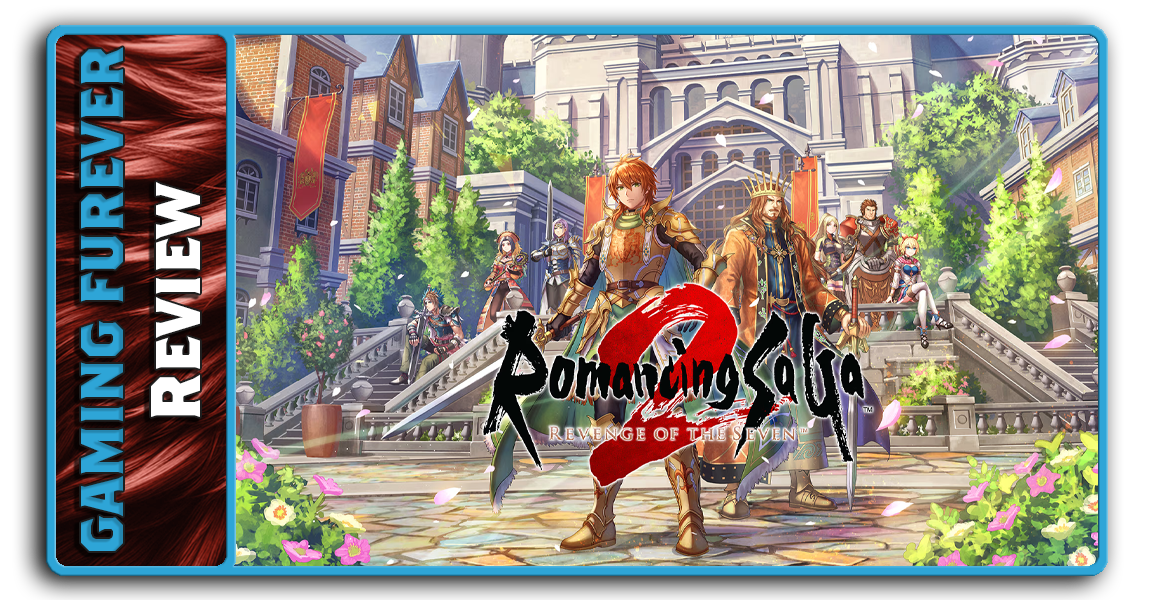The SaGa series is an interesting case in the JRPG world. It follows its own rules and was never quite as popular as Square Enix’s flagship Final Fantasy or even the much newer Bravely Default. Recently though, it's seen a bit of a resurgence with Romancing SaGa: Minstrel Song getting the remastered treatment and now Romancing SaGa 2: Revenge of the Seven. Even though it says 2, the SaGa series is quite a bit longer and like Final Fantasy, they don’t really relate to each other. So what is Romancing SaGa 2 about?
Romancing SaGa 2 revolves around the Varennes Empire. which is initially a small kingdom. The player steps into the shoes of the Emperor and thus works toward expanding the empire and opposing the Seven Heroes which have returned after a thousand years to wreak havoc on the world. At the start, players begin as Emperor Leon, who along with his son Gerard works to defeat monsters until the hero Kzinssie attacks Avalon, the Varennes capitol. Leon takes the fight to Kzinssie but fails, leaving the task to his son Gerard who marches on Kzinssie after repelling a goblin invasion. Thanks to special inheritance magic, Gerard has the knowledge and techniques of Leon, which allows him to gain the upper edge and ultimately defeat Kzinssie. After that, the game starts to open up with Gerard being formally crowned Emperor and informed of two new tasks: Bandits have seized control of Victor Canal which is essential for sea trade. And the mine in Ludon down south was overrun by monsters. This is the core gameplay loop of Romancing SaGa 2: After completing a quest or two in a region, the Empire can formally annex the region, expanding their influence and opening up more quests.
By completing quests, the Emperor can reap additional rewards such as unlocking new character classes for the Imperial Retinue and learning new skills. Some tasks can even help with others. Choosing to explore an optional side quest before tackling Victor Canal for example, can lead to unlocking the Vagabond class as well as offer an alternative route for retaking the canal. In between doing quests, the Emperor can also work toward developing Avalon. For a price, new facilities like a smithy and an incantations lab can be built. They’ll be finished after either a timeskip in which you choose a new Emperor or after defeating enough enemy encounters which incidentally is your main source of income.
Speaking of choosing new Emperors, that’s one of the biggest mechanics in this game. After certain missions or if the current Emperor falls in battle, you’ll be prompted to select a new emperor from a list of candidates which includes characters of the various classes available for your retinue. You can spend one generation as a ranger for your Emperor and a court mage for the next. The skills and proficiencies of one Emperor will pass straight down to the next. For example, whoever succeeds Gerard will also have fire and light magic as well as any techniques Gerard glimmered.
As one generation gives way to the next, techniques and spells will become archived and able to be taught to new characters provided they meet the requirements. Descendants of previously used characters will also retain their ancestors' skillsets. If Bear, a heavy infantry character, glimmers sword techniques, those techniques will not only be able to be taught to the next generation, but the next heavy infantry character will know them by default. Each playthrough is going to look different as you choose different classes for successive Emperors and decide which goals to pursue. You can choose to expand across the sea before going southward or focus on one part of the continent before moving to the next. Even putting off certain sidequests and objectives can have consequences as well such as choosing to retreat or if the Emperor just straight up dies. It really makes every decision count.
This also extends to decisions in combat, which is turn based as is tradition in JRPGs. A bar at the top of the screen keeps track of the order as it switches between the enemies and the retinue(Which consists of up to 5 characters including the Emperor). Retinue members can get access to a number of different spells and techniques to use in battle with a variety of effects. As combat ends, the retinue gains a number of technique points which goes toward enhancing hp, bp and proficiencies with the different skills used in the battle. The higher a character's proficiency with a certain skill, the more damage they will do using techniques of that type and the more skills they can learn. For example a character with higher proficiency in swords than rods will be more effective when using a sword. That said, characters also have base stats that you need to pay attention to. A court mage for instance, will have a higher magic stat than strength and thus will be better suited to using magic than trying to attack with melee weapons. Likewise a heavy infantry with higher strength and lower magic is much better off sticking to melee than trying spells. And those are just basic examples as other classes will have different strengths and downsides. Because of this, I’ve found a retinue is usually most effective when its members are varied in terms of the skills they can use, especially as enemies can be weak to, or resist different damage types. On that note, exploiting enemy weaknesses also fills an Overdrive bar. Once full, retinue members can activate it to combo attacks together and deal massive damage.
Speaking of, with 5 retinue members, you can arrange them in a variety of different formations. Initially players start with Free For All and Imperial Cross but as generations pass, you can learn more of them such as Free For All 2 and Witches Cap, each of which comes with their own strengths and downsides. There’s a lot to consider between the various skills, formations and different classes characters can be. Retinue members can even learn evasions to let them automatically avoid certain attacks. There’s a lot to learn and figure out. Fans of strategy like myself should feel at home here.
With characters constantly changing though, it’s hard to get attached to any of them. Which is fair since an Emperor likely wouldn’t get that close to his subjects anyway. Still, it's not quite the party based experience of other games in the genre. Fortunately Romancing SaGa does spend time on its locales. The world is a wide and varied place, from the medieval look and feel of Avalon, to harsh tundras, rocky canyons and wide open steppes. There’s a fair amount of different locations to see and explore, with different kinds of people living in them. Be it the migratory Saigo tribe in frozen lands, or the nomads of the plains. Many of the quests see the Emperor visit these areas and address some sort of problem the locals are having. A mineshaft could be filled with monsters or a child got lost in a cave. Solving these problems can lead to good rewards and interesting side content. Some of them may even have strings attached, like needing to be done in a single generation or cutting the empire's revenue should the problem remain unresolved. There are salamander people living on an island, mole people living underground that are endangered and even a mermaid who can be pretty easy to miss. There is a lot to see and do in this game and the cel-shaded graphics makes it nice to look at and adds a welcome vibrancy to the visuals. This remake also includes some new features which expands on the world even more. Such as the Memories of the Seven, which gives players a look at the events that lead to the Seven Heroes becoming corrupted. There’s also a cute little cyclops character named Mr S who can grant some very nice perks to those able to consistently find him all over the world.
The game isn’t perfect though, it can be difficult for the unprepared and a lot of the bosses are no joke. If you don’t spend time on some of the side stuff, you can miss out on new character classes and set yourself up for misery down the line. That said, I haven’t had too hard of a time with this game and it's not the hardest RPG by any stretch. The other problem I have with it is the music. First things first, the soundtrack is pretty good. It's a lot of the catchy high-energy type of stuff that this genre is known for. The battle themes and overworld themes are lovely…there just isn’t enough of them. I know it's probably a by-product of it being a remake of an older game but I found it recycled the music quite a bit without hardly any deviation. The same war drums battle march type theme you’d hear in a martial arts dojo is also used in a military fort across the ocean. The same ambient music you’d hear in a cave dungeon, can also be heard in a sewer or a mansion. The battle themes aren’t much better either but at least they tend not to overstay their welcome. It's kinda disappointing that they couldn’t add at least a little variety to the soundtrack given the effort they put into the visuals and even going as far as including voice acting. That all said, I do enjoy the battle theme for the Seven Heroes. Its a bop, it manages not to feel repetitive even during a drawn out fight and since it only shows up when you fight one of the Seven, you won’t be hearing it all the time. Though I do wish there were different versions of it for each of the Seven Heroes, it feels like a missed opportunity given how much importance was placed on the Seven.
Overall, Romancing SaGa 2 is a pretty fun experience and manages to remain unique in a genre where that's actually harder to do than you might think. Despite its shortcomings, I’ve enjoyed my time with this one and the different branching options adds some nice replayability to it. Definitely worth consideration if you like JRPGs and are in the mood for something different than the usual. Thanks for reading!




